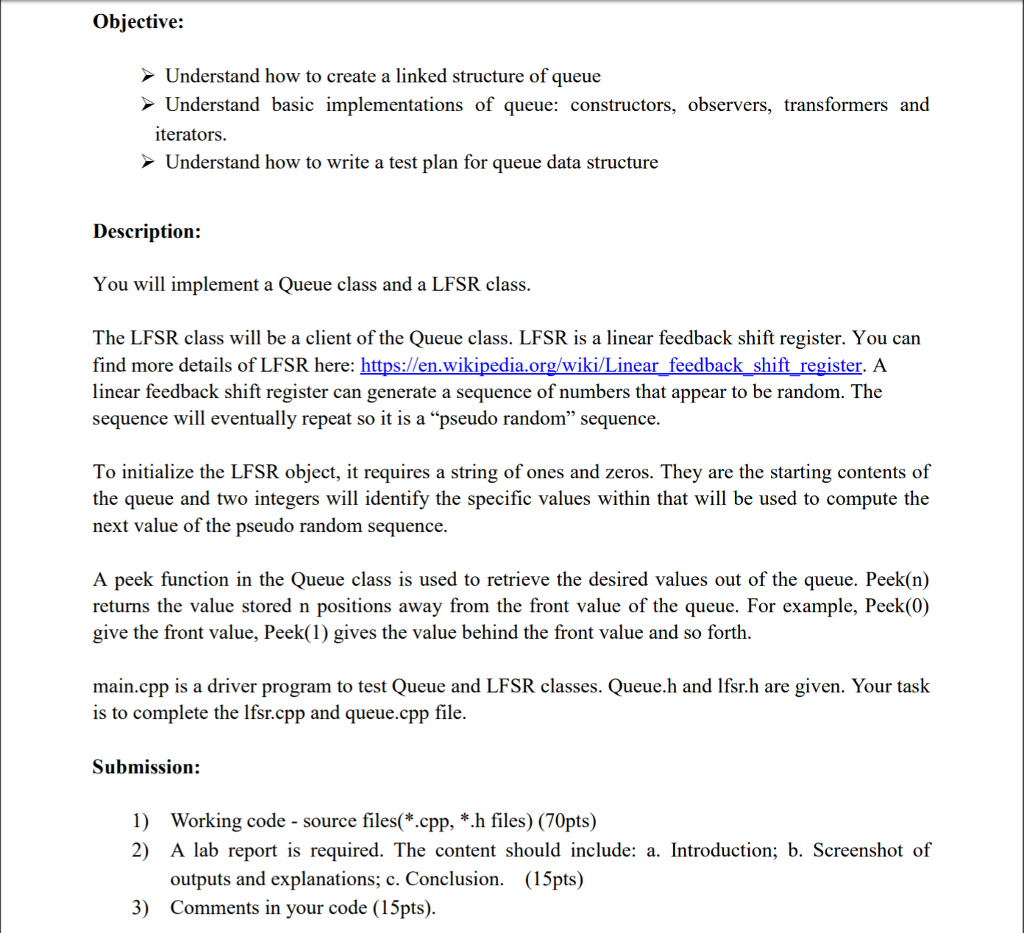
Objective: Understand how to create a linked structure of queue Understand basic implementations of queue: constructors, observers, transformers and iterators Understand how to write a test plan for queue data structure Description: You will implement a Queue class and a LFSR class The LFSR class will be a client of the Queue class. LFSR is a linear feedback shift register. You can find more details of LFSR here: https://en.wikipedia.org/wiki/Linear feedback shift register. A linear feedback shift register can generate a sequence of numbers that appear to be random. The sequence will eventually repeat so it is a "pseudo random" sequence To initialize the LFSR object, it requires a string of ones and zeros. They are the starting contents of the queue and two integers will identify the specific values within that will be used to compute the next value of the pseudo random sequence. A peek function in the Queue class is used to retrieve the desired values out of the queue. Peek(n) returns the value stored n positions away from the front value of the queue. For example, Peek(0) give the front value, Peek(1) gives the value behind the front value and so forth main.cpp is a driver program to test Queue and LFSR classes. Queue.h and lfsr.h are given. Your task is to complete the lfsr.cpp and queue.cpp file Submission: 1) Working code - source files(*.cpp, *.h files) (70pts) 2) A lab report is required. The content should include: a. Introduction; b. Screenshot of outputs and explanations; c. Conclusion. Comments in your code (15pts). (15pts) 3) Objective: Understand how to create a linked structure of queue Understand basic implementations of queue: constructors, observers, transformers and iterators Understand how to write a test plan for queue data structure Description: You will implement a Queue class and a LFSR class The LFSR class will be a client of the Queue class. LFSR is a linear feedback shift register. You can find more details of LFSR here: https://en.wikipedia.org/wiki/Linear feedback shift register. A linear feedback shift register can generate a sequence of numbers that appear to be random. The sequence will eventually repeat so it is a "pseudo random" sequence To initialize the LFSR object, it requires a string of ones and zeros. They are the starting contents of the queue and two integers will identify the specific values within that will be used to compute the next value of the pseudo random sequence. A peek function in the Queue class is used to retrieve the desired values out of the queue. Peek(n) returns the value stored n positions away from the front value of the queue. For example, Peek(0) give the front value, Peek(1) gives the value behind the front value and so forth main.cpp is a driver program to test Queue and LFSR classes. Queue.h and lfsr.h are given. Your task is to complete the lfsr.cpp and queue.cpp file Submission: 1) Working code - source files(*.cpp, *.h files) (70pts) 2) A lab report is required. The content should include: a. Introduction; b. Screenshot of outputs and explanations; c. Conclusion. Comments in your code (15pts). (15pts) 3)







